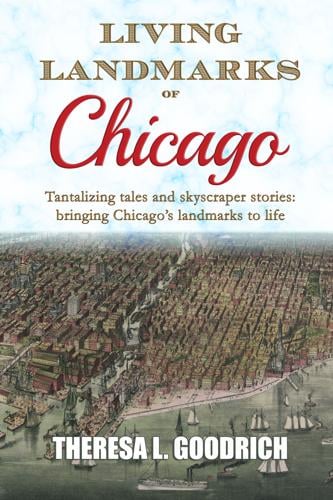Hidden in Chicago’s skyscrapers are thousands of stories. These towering buildings aren’t merely made of stone and steel, they’re also built of dreams and some very distinctive personalities. Here are ten things you didn’t know about Chicago’s skyscrapers.
1) The first skyscraper was inspired by bamboo huts and a bird cage.
William Le Baron Jenney, whose father owned a whaling fleet, sailed the world as a teenager. While in the Philippines, he noticed bamboo huts swayed in strong winds, but they didn’t break. Later in life, his wife put a heavy book on top of a bird cage. That last gave him an aha! moment that prompted the invention of the steel-framed skyscraper.
2) Chicago’s early skyscrapers float on a raft.
Chicago sits on a bed of clay, so how did early architects keep ever-taller buildings from sinking? John Wellborn Root designed a “raft” of crisscrossed iron bars encased in concrete, which essentially kept the buildings afloat.
3) The Auditorium Building’s sunken lobby isn’t Sullivan’s fault (not really).
Adler and Sullivan adapted Root’s raft design for the Auditorium Building, adding a layer of pitch to keep it watertight. It might have worked perfectly, but Ferdinand Peck decided he needed two more stories on the tower, causing the floor to sink up to three feet.
4) The Monadnock Block is not two, but four buildings in one.
The northern half of the Monadnock Block is often touted as a prime example of load-bearing masonry construction because of its six-feet thick walls, while the southern half is supported by a steel and iron frame. In reality, the block is actually made up of four distinct buildings, and only one uses the more modern construction.
5) The Monadnock’s revolutionary exterior owes its design to pigeons.
The northern half of the Monadnock is also known for its sleek exterior. Peter Brooks of the Brooks Brothers insisted that Burnham and Root design a simple face because projections and decorations meant dirt. Even worse, they would attract pigeons, and Peter hated pigeons.
6) Peter Brooks really, really hated pigeons.
He hated pigeons so much he wanted his building at the corner of LaSalle and Adams to be called anything but The Rookery and gave Burnham and Root a list of at least twenty potential names. You can see how that worked out.
7) Sullivan would have loved the Carbide & Carbon Building
Despite its similarity to a champagne bottle, the Carbide & Carbon Building, now the Pendry Chicago, was actually inspired by the second place winner of the Chicago Tribune design contest. Louis Sullivan made no bones about the fact that he preferred Eliel Saarinen’s design over the winning one by Howells & Hood.
8) Carson, Pirie, Scott & Co. was a Selfridge’s - for two months.
After being denied partnership with Marshall Field, Harry Selfridge decided to go out on his own. He bought the store to the south, Schlesinger & Mayer. That lasted all of two months. It wasn’t long before he moved to London.
9) The Party Boys of Freemasonry built the InterContinental.
When the Shriners, a fraternity based on fun, fellowship, and philanthropy, needed a new clubhouse, they decided to build the man cave to end all man caves. Their Medinah Athletic Club not only had the famous 14th-floor swimming pool, but also a bowling alley, an archery range, a shooting range, and a two-story boxing arena, as well as a miniature golf course.
10) A runaway built the Wrigley Building.
William Wrigley, Jr., got in so much trouble at school, and ran away so often, that his dad finally put him to work in his soap factory, then let him work as a traveling salesman at the age of 13. By the time he was sixty, he’d made so much money selling five-cent packs of gum, he paid cash for his skyscraper.
Theresa L. Goodrich is the force behind thelocaltourist.com, a site dedicated to telling in-depth stories of magnificent, quirky, and unique places. Theresa is an Emmy-winning author who is slightly obsessed with road trips, camping, Chicago, and history. She’s turned these passions into the Two Lane Gems book series and is also a contributor to Midwest Road Trip Adventures, an anthology written by local experts. In Living Landmarks of Chicago, excerpted here, she brings many of the Windy City’s most historic landmarks to life.
She teaches the Midwest Travel Network’s Writing Workshop and is driven, often literally, to inspire you to get off the interstates and explore the towns and communities that make this country a constant and welcome surprise.
(Order her latest book here: https://livinglandmarksofchicago.com/v)

Author/blogger Theresa L. Goodrich.








(0) comments
Welcome to the discussion.
Log In
Keep it Clean. Please avoid obscene, vulgar, lewd, racist or sexually-oriented language.
PLEASE TURN OFF YOUR CAPS LOCK.
Don't Threaten. Threats of harming another person will not be tolerated.
Be Truthful. Don't knowingly lie about anyone or anything.
Be Nice. No racism, sexism or any sort of -ism that is degrading to another person.
Be Proactive. Use the 'Report' link on each comment to let us know of abusive posts.
Share with Us. We'd love to hear eyewitness accounts, the history behind an article.